Back at CES this year, Toshiba announced its new BG4 lineup. BG4 stands for the fourth generation of the company’s ball grid array (BGA) SSD product line. These new SSDs come in the tiny M.2 2230 form factor making them ideal for ultra-mobile PCs, 2-in-1 notebook PCs, IoT/embedded devices, and server and storage array boot drives. Though the drives are small in size they do come in capacities ranging from 128GB to 1TB.
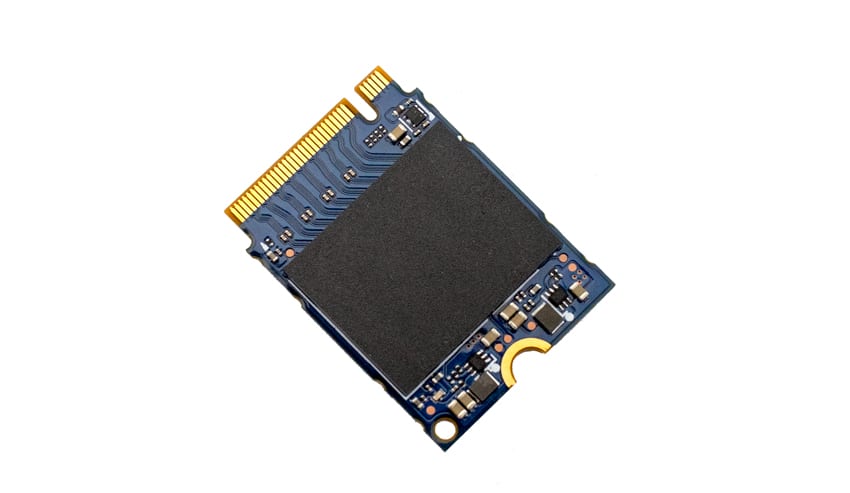
The BG4 drive leverages Toshiba’s 96-Layer BiCS FLASH to hit quoted speeds of up to 2.3GB/s read and 1.8GB/s write as well as throughput as high as 390K IOPS read and 200K IOPS write. Not too shabby for something slightly larger than an SD card. The BG4 is able to hit these numbers while only using 3.7W of power. For added security, Toshiba will also offer the BG4 in an SED model that supports TCG Opal Version 2.01.
The BG4 comes in moth an M.2 1620 single package as well as an M.2 2230 module form factor. For this review we will be looking at the 1TB (1,024GB) M.2 2230-S3 module.
Toshiba BG4 NVMe SSD Specifications
| Capacity | 1,024GB | 512GB | 256GB | 128GB |
| Form factor | M.2 2230-S3 | M.2 2230-S2 | ||
| NAND | BiCS FLASH TLC | |||
| Interface | PCIe Base Specification Revision 3.1a (NVMe Revision 1.3b) | |||
| Performance (max) | ||||
| Sequential Read | 2,300MB/s | 2,200MB/s | 2,200MB/s | 2,000MB/s |
| Sequential Write | 1,800MB/s | 1,400MB/s | 1,400MB/s | 800MB/s |
| Random Read | 390K IOPS | 330K IOPS | 330K IOPS | 200K IOPS |
| Random Write | 200K IOPS | 190K IOPS | 190K IOPS | 150K IOPS |
| Supply Voltage | 3.3V ±5 % | |||
| Power Consumption | ||||
| Active | 3.7W | 3.5W | 3.6W | 3.4W |
| L1.2 mode | 5mW | |||
| MTTF | 1.5 million hours | |||
| Physical | ||||
| Dimension | 30mmx22mmx2.38mm | 30mmx22mmx2.23mm | ||
| Weight | 2.6g | 2.5g | ||
| Temperature | ||||
| Operating | 0 to 85 °C | |||
| Non-operating | -40 to 85 °C | |||
| Humidity | 8% to 90% R.H. | |||
| Vibration | 196 m/s^2 { 20 G } ( Peak, 10 ~ 2,000 Hz ) | |||
| Shock | 14.7 km/s^2 { 1,500 G } ( 0.5 ms ) | |||
Toshiba BG4 NVMe SSD Design and Build
The Toshiba BG4 is a very small SSD with a single NAND pack on one side and blank on the other.
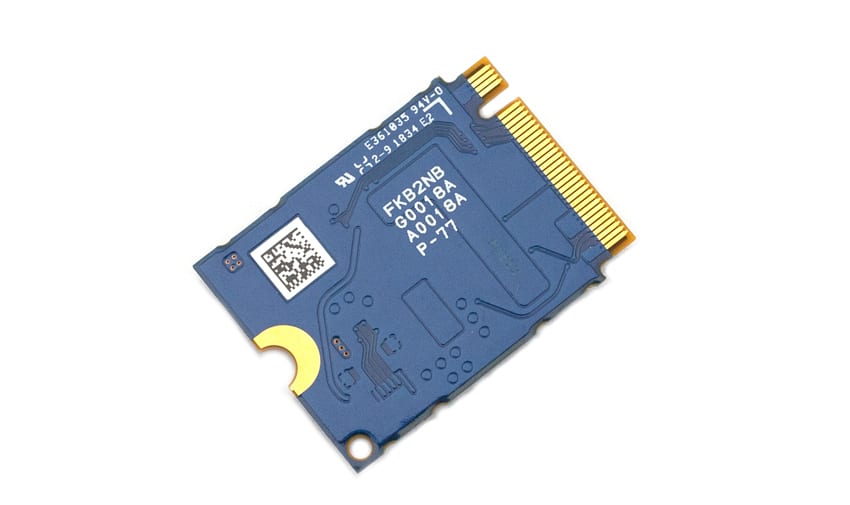
The drive itself is smaller than a standard SD.
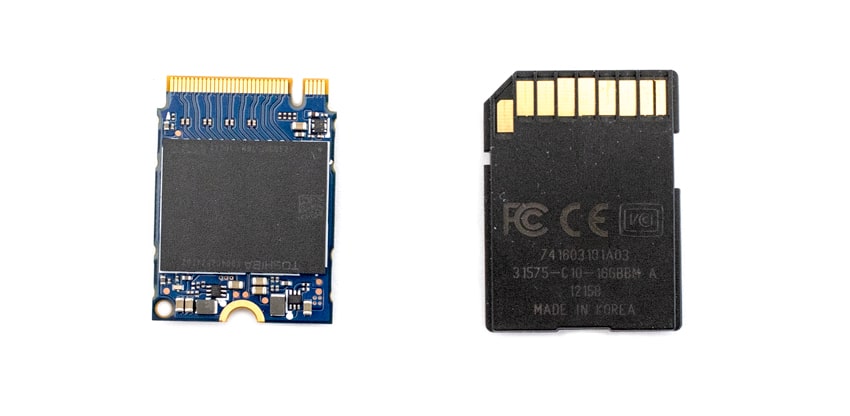
Toshiba BG4 NVMe SSD Performance
Testbed
The test platform leveraged in these tests is a Dell PowerEdge R740xd server. We measure SATA performance through a Dell H730P RAID card inside this server, although we set the card in HBA mode only to disable the impact of RAID card cache. NVMe is tested natively through an M.2 to PCIe adapter card. The methodology used better reflects end-user workflow with the consistency, scalability and flexibility testing within virtualized server offers. A large focus is put on drive latency across the entire load range of the drive, not just at the smallest QD1 (Queue-Depth 1) levels. We do this because many of the common consumer benchmarks don’t adequately capture end-user workload profiles.
Houdini by SideFX
The Houdini test is specifically designed to evaluate storage performance as it relates to CGI rendering. The test bed for this application is a variant of the core Dell PowerEdge R740xd server type we use in the lab with dual Intel 6130 CPUs and 64GB DRAM. In this case we installed Ubuntu Desktop (ubuntu-16.04.3-desktop-amd64) running bare metal. Output of the benchmark is measured in seconds to complete, with fewer being better.
The Maelstrom demo represents a section of the rendering pipeline that highlights the performance capabilities of storage by demonstrating its ability to effectively use the swap file as a form of extended memory. The test does not write out the result data or process the points in order to isolate the wall-time effect of the latency impact to the underlying storage component. The test itself is composed of five phases, three of which we run as part of the benchmark, which are as follows:
- Loads packed points from disk. This is the time to read from disk. This is single threaded, which may limit overall throughput.
- Unpacks the points into a single flat array in order to allow them to be processed. If the points do not have dependency on other points, the working set could be adjusted to stay in-core. This step is multi-threaded.
- (Not Run) Process the points.
- Repacks them into bucketed blocks suitable for storing back to disk. This step is multi-threaded.
- (Not Run) Write the bucketed blocks back out to disk.
The Toshiba BG4 did fairly well in our Houdini test scoring near the top on the non-Optane drives with a score of 2,624 seconds.

SQL Server Performance
We use a lightweight virtualized SQL Server instance to appropriately represent what an application developer would use on a local workstation. The test is similar to what we run on storage arrays and enterprise drives, just scaled back to be a better approximation for behaviors employed by the end user. The workload employs the current draft of the Transaction Processing Performance Council’s Benchmark C (TPC-C), an online transaction processing benchmark that simulates the activities found in complex application environments.
The lightweight SQL Server VM is configured with three vDisks: 100GB volume for boot, a 350GB volume for the database and log files, and a 150GB volume used for the database backup we recover after each run. From a system resource perspective, we configure each VM with 16 vCPUs, 32GB of DRAM and leverage the LSI Logic SAS SCSI controller. This test uses SQL Server 2014 running on Windows Server 2012 R2 guest VMs and is stressed by Dell’s Benchmark Factory for Databases.
SQL Server Testing Configuration (per VM)
- Windows Server 2012 R2
- Storage Footprint: 600GB allocated, 500GB used
- SQL Server 2014
- Database Size: 1,500 scale
- Virtual Client Load: 15,000
- RAM Buffer: 24GB
- Test Length: 3 hours
- 2.5 hours preconditioning
- 30 minutes sample period
When looking at SQL Server Output, the Toshiba BG4 came in second to last in our pack with 2,568.4 TPS.

For SQL Server average latency the BG4 again placed second to last with 1,099ms.

VDBench Workload Analysis
The peak 4K read performance of the Toshiba BG4 saw sub-millisecond latency throughout however the drive placed last over all with a peak performance of roughly 158K IOPS at a latency of about 820μs before falling off some.
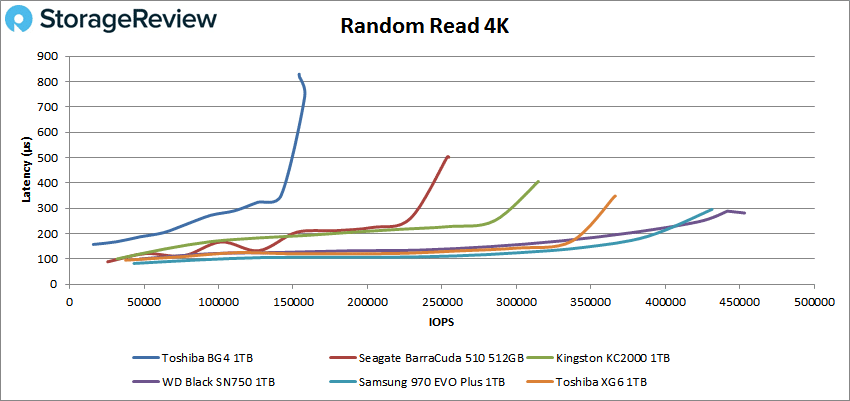
For 4K write performance, the BG4 once again came in last this time by a much larger margin. The drive peaked at 16,463 IOPS with a latency of 7.77ms. For a point of comparison, the top performer was well over 350K IOPS with sub-millisecond latency performance.
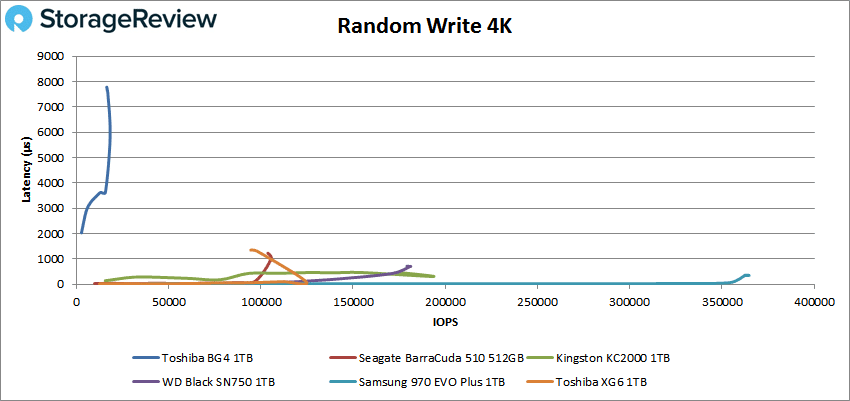
Switching over to sequential workloads, we see an increase in performance in our 64K read benchmark seeing the BG4 place roughly in the middle with a peak performance of 16,376 IOPS or 1.02GB/s at a latency of 977μs.
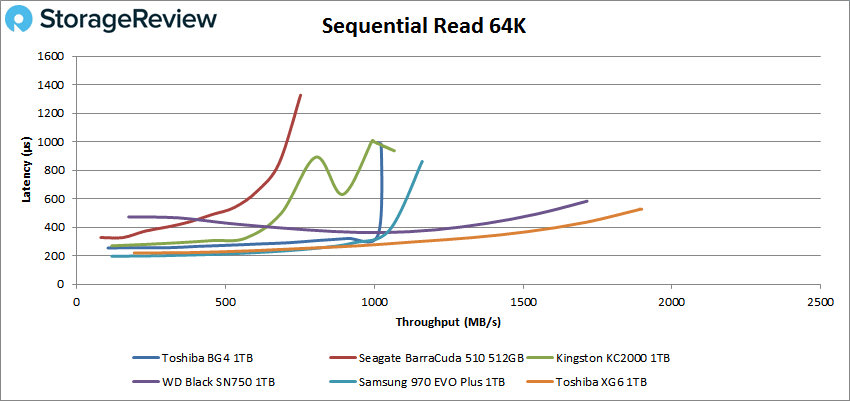
64K write again saw the drive drop to the bottom of the pack with a peak score of 1,565 IOPS or 97MB/s at a latency of 10.2ms.
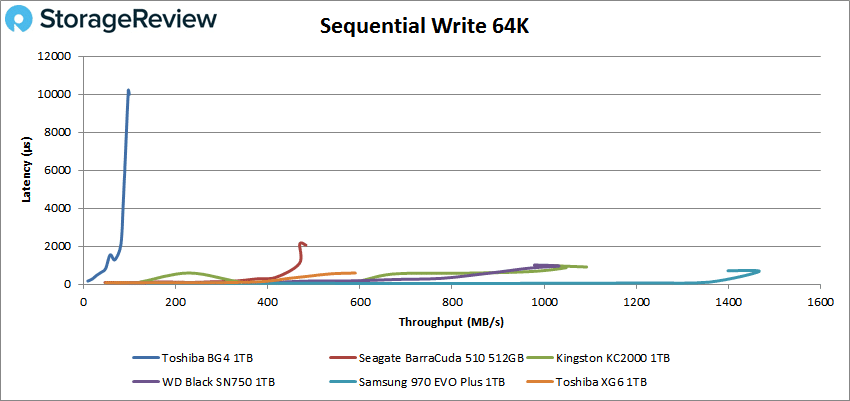
Next, we looked at our VDI benchmarks, which are designed to tax the drives even further. These tests include Boot, Initial Login, and Monday Login. Looking at the Boot test, the BG4 started and remained at the bottom of the pack with a peak performance of 39,869 IOPS and a latency of 851μs.
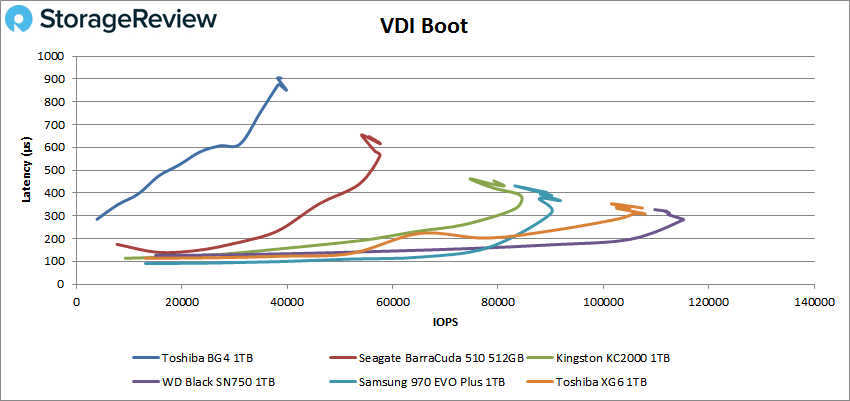
For VDI Initial Login, the BG4 stayed in the back with a peak performance of roughly 4,200 IOPS at a latency of 6.9ms.
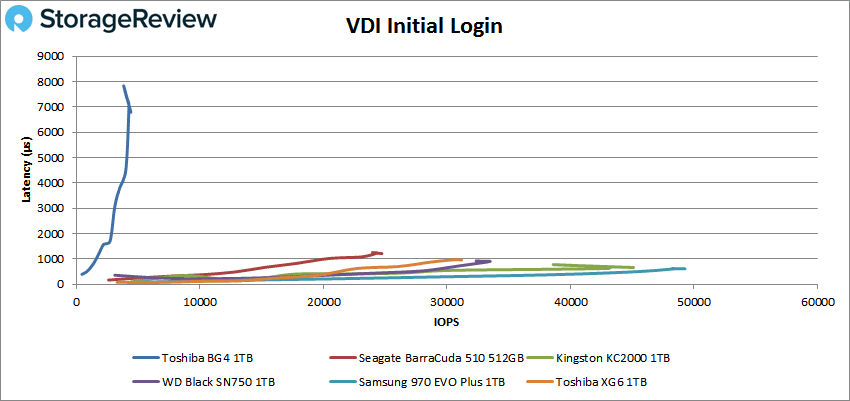
VDI Monday Login also saw the drive in the rear with a peak performance of 4,621 IOPS and a latency of 3.45ms.
Conclusion
The Toshiba BG4 is the fourth generation of Toshiba’s ball grid array SSD line. BGA products come in tiny form factors (M.2 1620 or M.2 2230 in this case) as to fit in ultra-mobile PCs, 2-in-1 notebook PCs, IoT/embedded devices, and they can also be used as a storage array boot drive. An interesting facet of the BG4 is that while it is still small like other embedded devices, it does come in capacities up to 1TB. The drive is also offered in an SED model supporting TCG Opal Version 2.01.
For performance there needs to be some perspective. While the BG4 has the capacity of several of the consumer SSDs we tested it against, it is much more specific in its use cases. With the exception of Houdini (where the BG4 scored near the top with 2,624 seconds), the BG4 performed poorly by comparison. However, it has high performance for an embedded device. The BG4 had SQL Server performance of 2,568.4 TPS with an average latency of 1,099ms. For VDBench, the BG4 saw scores such as 158K IOPS 4K random read, 16K IOPS 4K random write, and sequential scores of 1.02GB/s read in 64K and 97MB/s write in 64K. Our VDI benchmarks saw 40K IOPS boot, 4,200 IOPS Initial Login, and 4,621 IOPS for Monday Login.
For an embedded device with such a small form factor, it is nice to see such high capacities from Toshiba. While the performance was behind the other SSDs we compared it to, it was fairly strong for an embedded device and the prospective use cases it will find itself in. And of course, the Toshiba brand cachet should also help ease concerns around build quality and support which is often suspect in this segment of the market.


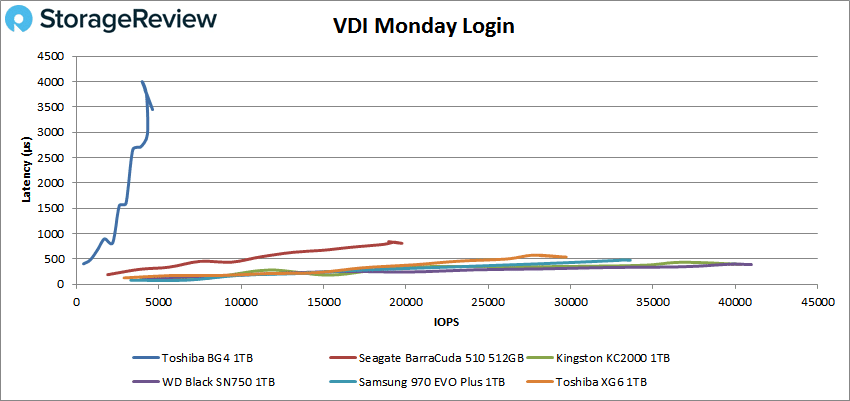


 Amazon
Amazon